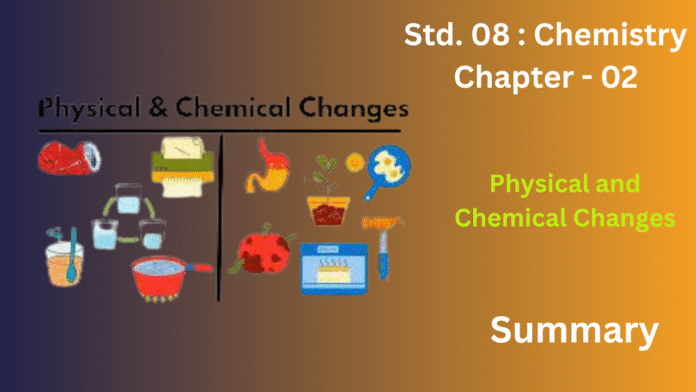The world around us is in a constant state of flux, with substances undergoing transformations that range from subtle to dramatic.
Imagine tearing a sheet of paper. You’ve created smaller pieces, but each piece is still paper. Similarly, when ice melts into water or water evaporates into steam, the substance remains H₂O; it’s simply transitioned between solid, liquid, and gaseous states. These changes are often easily reversible – you can refreeze the water, for instance – and typically don’t involve significant energy shifts or the creation of new materials. Other common examples include dissolving sugar in water (the sugar is still present, just distributed), breaking a glass (it remains glass), or magnetizing a nail (it’s still iron).
Consider burning that same piece of paper. It transforms into ash, smoke, and heat, and you can’t reverse this process to get the paper back. Chemical changes are generally difficult to reverse and often involve noticeable energy changes, such as the release of heat and light.
Several indicators can signal a chemical change. The formation of bubbles often suggests gas production, while the appearance of a solid in a liquid mixture (a precipitate) is another strong sign. A change in color, a shift in temperature (either heating up or cooling down), the emission of light or sound, or the release of a new smell are all strong indicators of a chemical transformation. Think of iron rusting, where the shiny metal becomes a brittle, reddish-brown substance. Cooking an egg is another example, as the proteins undergo irreversible changes due to heat.
In essence, a physical change is akin to changing an outfit – you look different, but your identity remains the same. A chemical change, however, is a complete transformation, like a caterpillar becoming a butterfly. One simply modifies the form or appearance of a substance; the other creates something entirely new. Grasping this distinction is fundamental to comprehending countless natural phenomena, from the melting of ice to the intricate processes within our own bodies and industrial manufacturing.
Exercise
Question 1.
Define:
(a) a physical change, (b) a chemical change.
Answer:
(a) Physical Change: It’s all about appearances changing without the substance itself changing at its core. Think of it like rearranging building blocks – you can make different shapes, but you still have the same blocks. Whether you’re squishing clay into different forms or melting an ice cube into water, the fundamental stuff remains the same. You’re just altering its form, size, shape, or its state (solid, liquid, gas). Often, you can even undo these changes, like getting the sugar back after it dissolves in your tea by letting the water evaporate.
(b) Chemical Change: This is where things get really interesting because the substance transforms into something entirely new with different properties. It’s like taking those building blocks apart and making something completely different out of them. When you bake a cake, the heat causes the flour, eggs, and sugar to react and form a new substance – the cake – which you can’t easily turn back into its original ingredients. Signs that a chemical change might be happening include things like a color change, bubbles forming (indicating a gas is produced), a solid forming where there were only liquids before, or a noticeable change in temperature as energy is either given off or absorbed. Burning wood is a classic example; you end up with ash and smoke, which are definitely not the same as the original piece of wood.
Question 2.
Classify the following as a physical or a chemical change.
(a) Drying of wet clothes
(b) Manufacture of salt from sea water
(c) Butter getting rancid
(d) Boiling of water
(e) Burning of paper
(f) Melting of wax
(g) Burning of coal
(h) Formation of clouds
(i) Making of a sugar solution
(j) Glowing of an electric bulb
(k) Curdling of milk
Answer:
Physical change
(a) Drying of wet clothes
(b) Manufacture of salt from sea water
(d) Boiling of water
(f) Melting of wax
(h) Formation of clouds
(i) Making of a sugar solution
(j) Glowing of an electric bulb.
Chemical change
(c) Butter getting rancid
(e) Burning of paper
(g) Burning of coal
(k) Curdling of milk
Question 3.
Fill in the blanks.
(a) The process of a liquid changing into a solid is called _________.
Ans : freezing
(b) A change, which alters the composition of a substance, is known as a _________ change.
Ans : chemical
(c) There is no change in the __________ of the substance during a physical change.
Ans : composition
(d) The reaction in which energy is evolved is called _____________.
Ans : exothermic reaction
Question 4.
Given reason:
(a) Freezing of water to ice and evaporation of water are physical changes.
(b) Burning of a candle is both a physical and chemical change.
(e) Burning of paper is a chemical change.
(d) Cutting of a cloth piece is a physical change, though it cannot be reversed.
Answer:
(a) Freezing water and water evaporating are physical changes. In both cases, only the form or state of water changes (liquid to solid, or liquid to gas), while its fundamental chemical makeup as H₂O stays exactly the same.
(b) The physical change involves the wax melting and then turning into a gas. Concurrently, a chemical change occurs as this wax vapor reacts with oxygen in the air, creating new substances like carbon dioxide and water, along with releasing energy as heat and light.
(c). This is a chemical change because a completely new substance is formed, and you can’t simply undo the process. Consider what happens: the paper, which is mainly cellulose, reacts with oxygen in the air. This energetic reaction turns the paper into entirely different materials: the flaky ash you see remaining, the smoke that floats away, and the heat and light that are given off. That ash isn’t paper anymore – its chemical composition is different. And once it’s burned, there’s no way to recombine the ash and smoke to get your original paper back.
(d)Cutting a piece of cloth is considered a physical change because it alters the shape and size of the cloth but does not change its fundamental chemical composition. The cloth is still cloth, just in smaller pieces.
The reason it “cannot be” (presumably, “reversed easily” or “reformed into the original single piece”) is that while you can rearrange the cut pieces, you can’t seamlessly fuse them back together to create the original, uncut piece of cloth without some form of intervention like sewing or gluing, which introduces new processes. Even then, it wouldn’t be identical to the original uncut piece. This irreversibility in a practical sense is a common characteristic of many physical changes, even though the underlying material remains chemically unchanged.
Question 5.
Give four differences between physical and chemical changes.
Answer :Physical changes modify a substance’s form but not its chemical identity, like water’s phase changes. They are often reversible with minor energy shifts. Chemical changes, conversely, yield new substances with distinct properties, as seen in rusting or cooking.


